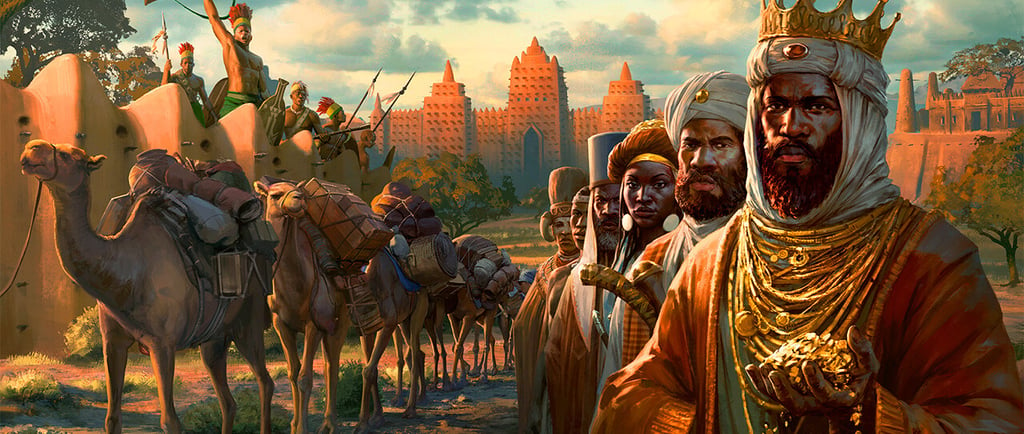The Rise and Fall of the Mali Empire's Monetary System: Lessons from Their Use of Gold and Silver
EDUCATION ON GOLD & SILVER


The Emergence of the Mali Empire and Its Wealth
The Mali Empire, established in the 13th century, rose to prominence in West Africa due to its strategic geographical positioning and prodigious wealth. Founded by Sundiata Keita around 1235, the empire's inception marked the beginning of an era characterized by unparalleled economic prosperity and cultural richness. Sundiata Keita's consolidation of smaller kingdoms laid the foundation for a vast empire extending from the Atlantic coast deep into the Sahel region, creating a centralized state capable of controlling significant trade routes.
Under subsequent leaders like Mansa Musa, the empire reached the zenith of its power and wealth. Mansa Musa's reign, from 1312 to 1337, is particularly noteworthy. His legendary hajj to Mecca in 1324 is often highlighted as a historical milestone. Accompanied by a grand entourage laden with gold, this pilgrimage not only showcased the Mali Empire's immense wealth but also served to establish diplomatic and economic ties with various states. Reports even suggest that the copious distribution of gold during this journey caused inflation in the regions he passed through, emphasizing the empire’s substantial influence on the global economy.
The Mali Empire's wealth was predominantly derived from its vast gold mines, particularly in regions such as Bambuk and Boure, renowned for their rich deposits. Furthermore, Mali’s strategic control over the trans-Saharan trade routes facilitated the exchange of gold, salt, and other valuable commodities, cementing its status as a dominant economic power. The interconnected network of trade not only bolstered Mali's economy but also promoted cultural and intellectual exchanges, contributing to the medieval era's broader economic landscape.
Overall, the Mali Empire exemplified a booming economy underpinned by formidable natural resources and robust trade mechanisms, making it one of the wealthiest and most influential empires of the medieval period.
The Monetary System: Gold, Silver, and Trade
The monetary system of the Mali Empire was intricately designed around the abundant use of gold and silver, which served as the primary currencies for both local and international transactions. Gold was particularly prevalent in the empire, mined extensively from regions like Bambuk and Bure. This precious metal underwent a sophisticated process of refinement before being minted into coins or fashioned into trade ingots, a practice that helped standardize economic transactions within and outside the empire's borders.
Local commerce heavily relied on these precious metals, with marketplaces in cities like Timbuktu, Gao, and Djenné bustling with activity. Timbuktu, in particular, emerged as a central trading hub, facilitating the exchange of goods and currencies. It was renowned not only for its economic vibrancy but also for its intellectual and cultural significance, drawing scholars and traders from across the globe. The use of gold and silver in transactions allowed for a stable and reliable monetary framework, securing the empire's economic might.
Trade caravans played a pivotal role in sustaining the empire's economy, traversing vast deserts to connect Mali with North Africa and the Mediterranean world. These caravans transported an array of goods, including salt—a commodity as valuable as gold—enabling a flourishing trade network. The intricate exchange systems capitalized on gold's unmatched value, with camel caravans being the lifelines that extended Mali's economic reach far beyond its geographical limits.
Economic policies under the leadership of Mansa Musa were instrumental in maintaining the integrity of the monetary system. His famed pilgrimage to Mecca, during which he lavishly dispensed gold, illustrated the empire's wealth but also necessitated policies to stabilize the economy against inflation. Regulations on gold mining, allocation, and distribution were carefully crafted to ensure fiscal health. Moreover, the adoption of gold and silver coins influenced both market dynamics and social structures, elevating the status of merchants and altering wealth distribution patterns within the society.
The Decline and Lessons for Modern Economies
The decline of the Mali Empire's monetary system and overall economic power can be attributed to several interrelated factors, both internal and external. Internally, the empire faced significant strife such as political instability and power struggles. As different factions vied for control, administrative cohesion weakened, impairing the efficiency of maintaining economic and financial order. Externally, the empire was subject to invasions from neighboring states and incursions that disrupted trade routes and economic stability. Over time, these pressures led to the fragmentation of the empire by the late 15th century.
One critical vulnerability was the Mali Empire's over-reliance on gold. While gold was a foundational element of their economy, the dependence on a single commodity made the empire susceptible to fluctuations in gold’s value on the international market. As demand for gold waxed and waned, so did the stability of the Mali monetary system. The economic resilience of the Mali Empire waned further as other global entities began sourcing gold from different regions, undercutting Mali's dominance in gold trade.
Alongside the issue of gold dependency, the decentralization of trade and overextended borders hastened the empire's economic decline. As trade networks expanded beyond the manageable scope, controlling and securing these routes became increasingly unsustainable. This lack of centralized control weakened the ability to collect taxes effectively and protect against economic exploitations by outside forces.
Modern economies can extract valuable lessons from the Mali Empire’s experience. Diversifying economic foundations is crucial to mitigate the risks associated with dependency on a single commodity or sector. Stable and robust financial institutions need to be established and maintained, ensuring resilience against economic perturbations. Additionally, the prudent management of natural resources can prevent over-exploitation and ensure sustainable economic growth.
The Mali Empire's monetary challenges illustrate the importance of economic diversification, robust financial governance, and sustainable resource management. By internalizing these lessons, contemporary economies can better navigate the complexities of the global market and avert potential economic pitfalls associated with over-reliance on singular economic pillars.
